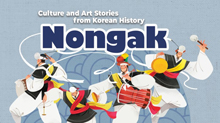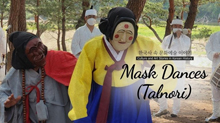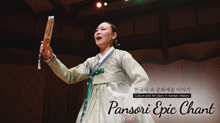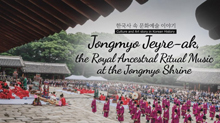The Story of Culture and Arts
- Image resource of Korean history
- Documents from History TextBooks
- Culture & Art Stories from Korean History
- Culture & Art Stories from Korean History - Korean
- National Institute of Korean History
- History net
- About the site
- Introduce
-
Numerous topics related to Korean culture and art are mentioned in middle and high school national history textbooks, but most of them are briefly described by era, making it difficult to understand their concepts, transition processes, and characteristics.
<Culture & Art Stories from Korean History> produces and provides video materials based on expert commentary on the flow, change process, characteristics and characteristics of each major topic in the field of culture and art in Korean history.

Scenario
In Andong Hahoe Village, a mask dance, or a village ritual asking for peace and plentiful harvests in the New Year, is performed. These dances began as a way of wishing for peace and harmony during communal times of need.
Koreans of old, who chased away life’s worries and sorrows with lighthearted mask plays. Let’s look at mask dances, the satirical and humorous flowers of folk art.
Finding Joy in Life’s Troubles – Mask Dances, Overcoming Hardships
Mask dances are a performance art that tells a story through song and dance while wearing masks. They have been around since prehistoric times, hoping to solve community problems through a performance during a communal ceremony.
Between the Three Kingdoms and the Goryeo and Joseon periods, they developed into folk performances that expressed the emotions of the people. Paintings depicting mask dances indicate they typically occurred amidst large gatherings.
Imagine the delight of commoners to watch a satirical performance about the aristocracy.
Mask dances can also be found in a poem written by Kang I-cheon titled, “Namseong Gwanhuija.” The poem takes its name from a mask dance the author saw performed outside Seoul’s South Gate. The version depicted in the poem can also be seen today.
Where is that old monk coming from? (老釋自何來)
He walks with a monk’s staff and dons monk’s robes, (拄杖衣袂裕)
He hunches over, barely able to stand up straight, (龍鍾不能立)
His beard and eyebrows are completely white. (鬚眉皓如鷺)
He is followed by a novice monk, (沙彌隨其後)
Hands together, he kneels and stands in prayer again and again, (合掌拜跪屢)
yet he is so frail. (力微任從風)
How many times has he fallen? (顚躓凡幾度)
- Namseong gwanhuija” [Observing a Clown Outside the South Gate] / by Kang I-cheon
“Mask dances helped elevate the problems of the socially disadvantaged, lessening the distance between the classes. They were created to match the roles they represented. Dancers need to bypass the fixed expression of their masks and instead express themselves through their bodies and words.” Heo Changryeol / Master of the Goseong Ogwangdae Mask Dance
The mask dance is a valuable part of Korea’s intangible cultural heritage and embodies the Korean people’s joys and sorrows. The art can be divided into two styles based on its origin and formation.
Village ritual mask dances, closely related to a village community’s ancestral ceremonies, vary depending on local traditions.
The Bukcheong Lion Mask Dance is a folk performance held on the 15th day of the New Lunar Year. It is similar to the Treading the Earth God performance but here the lion plays the main role.
The Gangneung gwanno gamyeongeuk dance, performed during the Dano Festival, only contains dances and movements, no lyrics.
Bonsandae mask-play performances are performed at state events. They were formed and influenced by the Bonsandae Troupe, a professional mask-play troupe that went on frequent regional tours.
The Bongsan talchum in Hwanghae-do, the Sandae nori in Seoul and Gyeonggi-do. And the Yaryu dance and the Ogwangdae dance in the Nakdong River Basin of Gyeongsang-do,. They all belong to the Bonsandae mask play performance. Each performance is a product of history that embodies the love of the common people.
Shout Freely and Let the Mask Lead!
Mask dances allow one to put on a mask and freely release any pent-up emotions. Although each region’s mask dance has its own unique characteristics, they all carry a similar message.
The monk’s stage, which critiqued Buddhist monks’ hypocrisies and wrongdoings, The aristocrat’s stage, which satirized the aristocracy’s arrogance, hypocrisy, and privileged status, And the old woman’s stage, which discusses the hardships faced by the people, These are the most common themes and stages performed.
In mask dances, bountiful critical satire and tongue-in-cheek humor are hidden within the characters’ masks. When looking at Chwibali’s mask, we see someone who is drunk yet has the vigor of a young man. This shows us Koreans of the past put a lot of thought into each mask. The dancing also meticulously expresses each human emotion.
“When I dance the Leper’s Drum dance, I first express the leprosy. It's not only about mimicking a leper, but about expressing the stories of everyone. It is a complex yet bittersweet tale of how we didn’t give up despite this hardship and finally overcome the resentment.” Heo Changryeol / Master of the Goseong Ogwangdae Mask Dance
Epilogue
Mask dances, temporary escapes from the hardships of the period through their lively, exaggerated expressions, and cheerful yet straightforward satires. A performance culture that continues today, transcending generational barriers by sympathizing with the deepest feelings of the audience.
“The performers put their own thoughts and ideologies into the show. Thus, The dance lives and breathes. Because living people dance it, the dance also comes alive and continues to evolve. One might even say it survives by adjusting to the times.” Heo Changryeol / Master of the Goseong Ogwangdae Mask Dance
[Epilogue]
Must-Know Facts on Culture and Art in Korean History
1. Mask dances are a performance art where performers wear masks while dancing, singing, and cracking jokes.
2. Mask dancing is called talchum in Gwanghae, sandae nori in Seoul and Gyeonggi Province, and aryu or ogwangdae in the Nakdong River Basin in Gyeongsang Province.
3. Mask dances in the Joseon Dynasty were satirical works, criticizing the arrogance and misguided awareness of the aristocracy, as well as comedies, representing both the joys and sorrows found in commoners’ lives.







